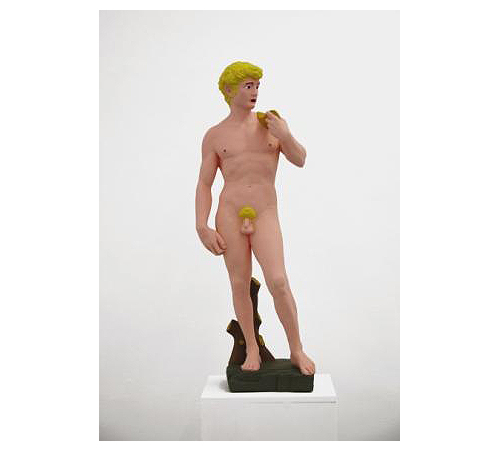| Hans-Peter Feldmann David, 2006 |
| Sculpture | Polychrome sculpture |
| 115 cm |
 |
| In creating his work, Hans Peter Feldmann usually uses images and objects that he finds easily at hand: stickers, postcards, snapshots, photographs he’s found and decorative objects. Once the material has been selected, he carries out a series of simple procedures: highlighting it, changing its context or colouring it in such a way that, rather than creating art, he seems to be limiting himself to finding it and making it visible. In the 1970s (an era in which the media did not use colour as much as they do today) Feldman began to colour various types of photographs and some small plaster reproductions of classical sculptures. His declared intention was to make the photographs and objects more attractive, although he was conscious that this would not be to everybody’s taste. The colour, both in the photographs and sculptures, emphasised and highlighted the values and dreams they represent. The sculptures “David” and “Eve” are plaster reproductions which seem to have been taken from an archive of the sculptural forms of classical antiquity, although it is difficult to pin down their exact point of reference. They are reminiscent of Greco-Roman statuary, but appear to have been adapted to other canons. They are reproductions from the world of popular culture; objects extracted from the cheap and sentimental world of kitsch. Before being painted, they were designed to decorate or adorn some space, which they would have done thanks to some perplexing relationship they had with the history of art and its values. The colour, vivid and without shades, is applied in a simple and flat way like children would paint. Thanks to this, these sculptures augment the seductive element associated with kitsch objects, and more evidently demonstrate their integration into the dream-filled world of popular culture. The titles confirm that we are being presented with the myths of Western history represented a thousand times. Eve symbolises the first woman and David the hero who faced Goliath. However, one might say that they have lost (and also gained) some characteristics along the way that differentiate them from the original myths and their representations. When seen for the first time in the context of an artistic exhibition (thus confirming their status as works of art), we have a sense that they are completely iconoclastic. And yet, we immediately feel attracted to them and find them amusing. Feldmann, with the apparent light touch that characterises much of his work, is forcing us to confront our notions of taste while also obliging us to reflect on our ideas about art and the categories and values we associate with it. The sculptures clearly demonstrate how cultural concepts are related to education and class. In 1997, when he was invited to participate in the “Dream City” project, which consisted of invitations sent out to several artists to make public artworks in Munich, Feldmann made a new three-metre-high version of “David” that he sited on a neoclassical roundabout. Traditionally, public sculpture has represented social values such as justice, worth and self-denial, while it is currently being used to emphasise the importance of huge corporations or how well the city is being administered. Presenting a three-metre-high David (closer to the deceptive seduction of the contemporary mass media than to the traditional or current values of public sculpture), Feldmann was playing with the perceptions of art, cultural value or excellence which are attributed to the sculptures that populate our cities. These coloured sculptures, introduced within an artistic framework, act as Trojan horses. Seductively colourful, they easily attract us, but afterwards oblige us to revise our ideas and beliefs; a characteristic of Feldmann’s apparently insubstantial works. |
Helena Tatay |

